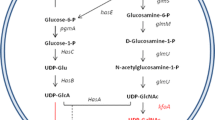Abstract
The effects of the addition of lysozyme and forced aeration on the rheological properties and production of hyaluronic acid by Streptococcus zooepidemicus were investigated. Lysozyme was added to the culture broth in two pulses during the exponential and stationary phases of a fermentation carried out in a rotary shaker (150 rpm), using 200 mL Erlenmeyer flasks. The effect of aeration was evaluated by feeding air into a 2.5 L fermentor at a 2 vvm rate. The effects were analyzed in terms of concentration, viscosity, viscoelasticity, and molecular weight of the hyaluronic acid produced.
Similar content being viewed by others
References
Holmström, B. and Ricici, J. (1967), Production of hyaluronic acid by a Streptococcal strain in batch culture. Appl. Microbiol. 15, 1409–1413.
Akasaka, H., Komasaki, H., and Arai, T. (1989), Fermentation method for producing hyaluronic acid. United States Patent: 4,801,539.
Brown, K. K., Ruiz, L. C., and Rinj, I. (1988), Ultrapure hyaluronic acid and method of making it. United States Patent 4,782,046.
Ellwood, D. C., Evans, C. G. T., Dunn, G. M., McInnes, N., Yeo, R. G., and Smith, K. J. (1995) Production of hyaluronic acid. United States Patent 5,411,874.
Ellwood, D. C., Evans, C. G. T., Dunn, G. M., McInnes, N., Yeo, R. G., and Smith, K. J. (1996) Production of hyaluronic acid. United States Patent 5,563,051.
Stanghl, S. (2000), Method and means for the production of hyaluronic acid. United States Patent 6,090,596.
Kim, J., Yoo, S., Oh, D., et al. (1996), Selection of a Streptococcus equi mutant and optimization of culture conditions for the production of high molecular weight hyaluronic acid. Enzyme Microbial Tech., 19, 440–445.
Johns, M. R., Goh, L., and Oeggerli, A. (1994), Effect of pH, agitation and aeration on hyaluronic acid production by Streptococcus zooepidemicus. Biotech. Lett., 16, 507–512.
Swann D. A, Sukkivan, B. P., Jamieson, G., Richardson, K. R., and Singh, T. (1990), Biosynthesis of hyaluronic acid. United States Patent 4,897,349.
Nimrod, A., Greenmam, B., Kanner, D., Moshe, B., and Landsberg, Y. (1988), Method of production of high molecular weight sodium hyaluronate by fermentation of Streptococcus. United States Patent 4,780,414.
Armstrong, D. C. and Jons, M. R. (1995), Improved molecular weight analysis of streptococcal hyaluronic acid by size exclusion chromatography. Biotechn. Tech. 9, 491–496.
Steffe, J. F. (1996), Rheological Methods in Food Process Engineering. Michigan State University, Freeman Press, USA.
Author information
Authors and Affiliations
Rights and permissions
About this article
Cite this article
Ogrodowski, C.S., Hokka, C.O. & Santana, M.H.A. Production of hyaluronic acid by Streptococcus . Appl Biochem Biotechnol 122, 753–761 (2005). https://doi.org/10.1385/ABAB:122:1-3:0753
Issue Date:
DOI: https://doi.org/10.1385/ABAB:122:1-3:0753




